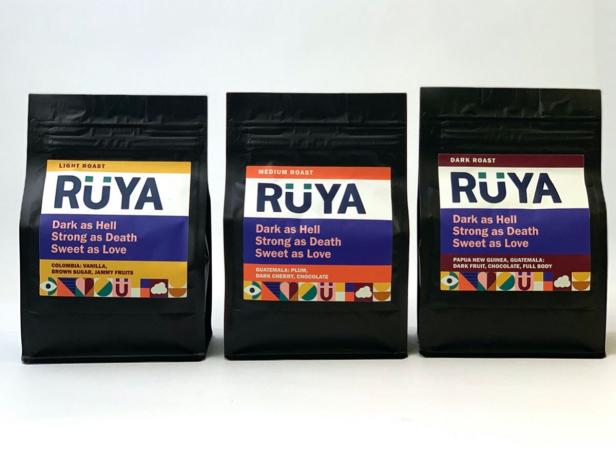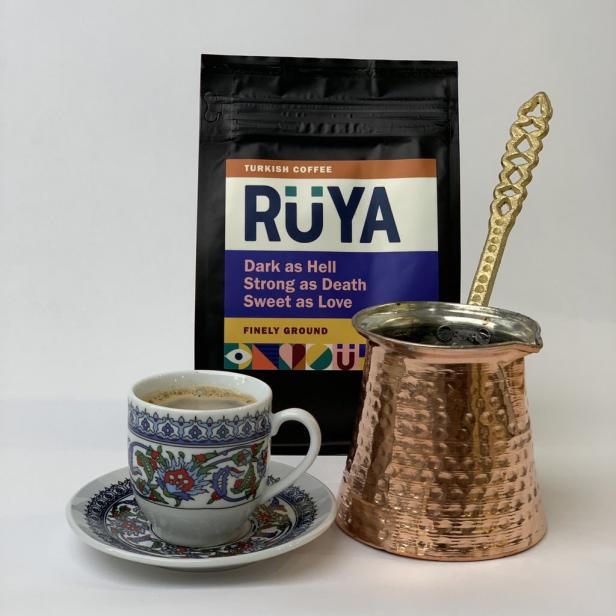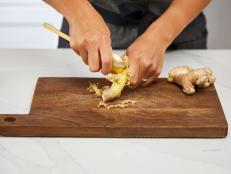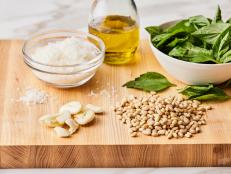How to Make the Perfect Cup of Turkish Coffee, According to a First-Generation Turkish-American
It’s an art, not a science.

Photograph by Hailey Bollinger/@haileybollingerphoto for IG
Dark as Hell. Strong as Death. Sweet as Love: Those are the words you’ll find printed across the front of every bag of Ruya Coffee. The Cincinnati-based business, which was founded by Melis Aydoğan in 2018, is on a mission to rewrite the narrative of immigrants in America, while also creating a place where they can share their own unique cultures, stories and traditions. “It’s a welcoming way for someone to step into a new culture and learn about a new type of person, an immigrant in their community,” Melis says.
One such Ruya is doing that is by educating people about the 500-year-old artform of preparing Turkish coffee. Popular throughout Turkey, the Middle East, Europe and Greece, Turkish coffee is celebrated for its strong, robust flavor and its thick, velvety texture. While the term Turkish coffee actually refers to the brewing method behind it — not the coffee beans themselves — achieving the perfect cup can take more than a few practice tries before you get it right. Here’s everything to keep in mind before brewing your next drink.
Pay Attention to Your Coffee Beans
If this marks your very first-time purchasing whole coffee beans or finely-ground coffee grinds for this type of brewing method, you’ll want to avoid blends that are flavored or have any other kind of sweeteners added to them. "I think overall if you’re shopping for Turkish coffee, I would recommend nothing with flavors in it," Melis advises. “Some of the Turkish coffees include different flavors, like mastic, hazelnut, caramel or vanilla, and I think the more additives you have, the less fresh it’s going to be.”
Though there’s a variety of pre-ground Turkish coffees available for purchase online and in grocery stores, the freshness of it is often lacking and you won’t know when the beans were originally roasted or ground. "I've always wanted Ruya to be as fresh as possible! So as soon as you place an order, [your coffee] is roasted and then ground right away — days later the coffee you receive on your doorstep is the freshest Turkish coffee that you can get in America!” Melis shares talking about the light, medium and dark whole bean coffee roasts available for purchase on Ruya’s website.
Each of Ruya’s coffee roasts are also ethically sourced and the farmers behind them are paid a fair living wage, two other characteristics that Melis believes is important when you’re buying a product that hails from another culture or heritage. "It's very sad to me when businesses in general capitalize on trends that aren't authentic to their culture," she shares, noting the lack of transparency often associated with other Turkish products. “It's disappointing when companies abandon people coming from that culture in pursuit of trends. Cultures are forgotten,” she says. “And so, I ensure in every cup of Ruya there is a cultural conversation. Ruya brings new people together. Every product I make is authentic to Turkey, the Mediterranean and the Middle East. Whether it's chocolate with Turkish coffee and cardamom, my [Turkish coffee] kit, my beer, literally everything is ethically sourced and is authentic to Turkish people in general — so my culture and 500-years of tradition lives on for the next generation to taste, and love!" This is the main reason why the ibrik, the coffee cup and saucer that are included in Ruya’s Turkish Coffee Kit are made by, and come directly from, Turkish artisans.
It’s an Art, Not a Science
While water temperature plays an extremely important role when you’re preparing coffee with tools like the French press, pour over sets and cold brew setups, that isn’t at all the case when it comes to Turkish coffee. “When I was teaching other Americans to brew Turkish coffee, they would get so scientific, especially in this third wave coffee culture. People ask me 'what's the temperature? How many grams? How many milliseconds?' I'm like chill out! This is art, habibi! So, we’re just going to take a scoop of coffee!” Melis shares, laughing. In fact, the entire brewing process actually begins by filling your ibrik, or long-handled copper pot, with cold unfiltered water.
The amount of water you’re using should match how many cups of coffee you want to make, so think of it as one cup of water for every cup of coffee. You’ll then mix in two tablespoons of your superfine grind coffee and cook it over medium heat until it boils and a nice froth forms at the very top. “Once it’s on the stove, you don’t need to touch it very much,” Melis shares. “You kind of let it sit. I think it’s meditative to watch my coffee boil up and foam. As you notice the foam rising closer and closer to the top of your ibrik, bring down the heat, turn off the stove, and swiftly pour it into the cup so you get that nice crema on top of the Turkish coffee. It's so beautiful.”
Unlike other coffee beverages, which are sweetened after the coffee is made, you’ll want to add sugar, cardamom or any other sweeteners of your choosing to your coffee grinds and water before boiling it. This allows the sugar and spices to combine fully with the coffee, resulting in a strong and balanced flavor. Waiting until your coffee is fully cooked to add the sugar just won’t taste the same!
Patience is Key!
Patience is a virtue, especially when it comes to successfully brewing a cup of Turkish coffee. While waiting for your coffee to cook can be difficult, rushing your brewing process can result in a large mess. “I think a lot of people get a little impatient and blast the heat on high — and suddenly their coffee volcanoes over the ibrik, so don’t do that!” Melis cautions.
In fact, the best thing for you to do is sit back and appreciate the experience. “Be patient. Enjoy the process. Watch the foam rising. Ahhh, smell the coffee,” Melis advises. Reminding yourself that you’re doing more than just making a cup of coffee is also extremely important. “Think about how you — the person who’s actually brewing the coffee — are carrying-on a 500-year legacy, brewing coffee like the sultans and sultanas did in the Ottoman Empire," she says. "I think it's so special to celebrate where Turkish coffee comes from and to have a little bit of culture with your caffeine!"
Any Heat Source Will Do
If you’re wondering whether the brewing process changes at all if you’re using a gas stove versus an electric one, fret not! Just like the temperature of your water, the source of your heat doesn’t need to be all that precise or exclusive. In fact, any heat source will do the trick. “I’ve done this over a Bunsen burner a lot,” Melis admits. “You just need a heat source; you need something to boil the water.” Though Melis notes that she prefers using a gas stove because she likes “seeing the fire,” practically any heat source can work. “Back in the day people did this in sand,” she adds.
No matter what heat source you decide to use, you’ll want to keep the heat steady. “Ensure that you’re cognizant that you’re placing the ibrik on a part of the stove so that the heat is evenly distributed on the bottom,” Melis advises. This means that, if you are in fact using an electric stove, you should place your ibrik on the parts of it that actually conduct heat.
Melis has also found that shifting your ibrik around from time to time helps in that instance too. “If you move the ibrik a little bit more, it helps speed up the process a little bit,” she shares. “That is something I have learned on an electric stove — moving the ibrik around helps bring that foam up faster.”

Photograph by Brian Spitzig/@bpsitz on IG
Serve with a Glass of Water and a Sweet
Once you’ve successfully brewed your Turkish coffee, it’s finally time to serve it. If you’re looking to serve it the traditional way, you’ll need three things: a tray, a glass filled with water and a plate of Turkish delights, baklava or some other kind of sweet treat. The purpose of the water is two-fold; taking a sip of it before you begin drinking your coffee acts as a way to clean out your palate, ensuring that you get the very best enjoyment out of your first taste. The second purpose is for afterwards. “It is very traditional to have a cup of water to wash away the grinds after you finish drinking it,” Melis says, talking about the coffee grinds you’ll find lining the bottom of your cup. The Turkish delight is also a nice way of adding a little extra sweetness to the experience, especially if you’ve opted not to add any sugar or additional spices into your coffee.
Don’t Drink the Grains!
As we’ve already stated, Turkish coffee is made from a combination of cold water and super-fine ground coffee. These grinds will settle to the bottom of your coffee cup when you pour it out of your ibrik. The grounds are often used to tell people’s fortunes afterwards. Though they won’t do anything to you if you do accidentally consume them, you really shouldn’t drink your coffee grinds. “When Americans have Turkish coffee for the first time, they don’t realize that they are not supposed to shoot back the grinds,” Melis shares. Though it’ll be tempting to fully empty your coffee cup to the dregs, once your coffee’s gone, it’s time to call it a day: “Once you finish the liquid, you’re done. You don’t need to gulp back the coffee grinds at the bottom of the cup. If you do, you’ve eaten your Turkish coffee fortune, and no one wants that!
Related Content:

































































